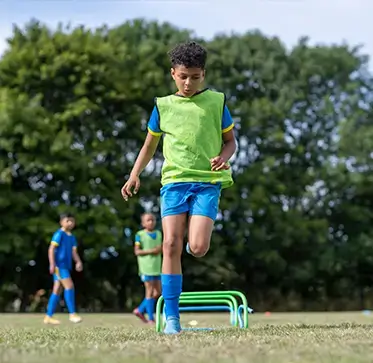CRFC BLOGS
LATEST BLOGS & NEWSLETTERS
Youth Soccer Attacking Drills: Mastering the Art of Offensive Play
In soccer, developing strong attacking skills is crucial for any youth soccer player. These skills help players understand how to create scoring opportunities, work effectively as a team, and ultimately score goals. This article provides a comprehensive guide to the best-attacking youth soccer drills for various age groups and formations, ensuring young players can develop their offensive abilities in an engaging way.
Understanding the Basics of Attacking in Soccer
A good attacker possesses several key skills including dribbling, shooting, passing, and quick decision-making. Dribbling allows players to move around defenders and create space. Shooting accuracy is essential for converting opportunities into goals. Precise passing helps maintain possession and set up scoring chances. Quick decision-making enables attackers to react swiftly to changing game situations. These skills combined make a strong attacker who can challenge any defense.
Importance of Teamwork and Communication
Effective attacking in soccer is not just about individual skills; it’s also about teamwork and communication. Players need to understand each other’s movements and intentions to create effective attacking plays. Clear communication ensures that players can coordinate their efforts, making it easier to break down defenses. Teamwork helps in maintaining possession, creating space, and executing strategic plays that lead to goals.
Role of Formations in Attacking Play
Different formations can significantly influence attacking strategies. Understanding how formations like 3-5-2 and 4-3-3 impact offensive play can help coaches design drills that maximize their players’ potential. For example, a 3-5-2 formation emphasizes wing play and midfield dominance, while a 4-3-3 formation focuses on utilizing width and the forward three to create scoring opportunities. Knowing the strengths and weaknesses of each formation allows teams to exploit their opponents effectively.
Youth Soccer Attacking Drills
Youth soccer attacking drills are essential for developing young players’ offensive skills. These drills focus on improving dribbling, passing, and shooting, helping players become more effective in creating and converting scoring opportunities. By practicing these drills regularly, young athletes can enhance their teamwork and strategic thinking on the field. =-[p+
2v2 with Target Players to Small Goals
This drill focuses on teamwork and creating scoring opportunities in tight spaces. Players work in pairs to move the ball towards small goals, enhancing their passing and finishing skills. The objective is to develop quick thinking, close control, and effective communication. By practicing in a confined area, players learn to make quick decisions and improve their ability to find and use space under pressure.
1v1 Battle - Attacking and Reaction Drill
In this drill, players face off one-on-one, improving their dribbling, defending, and quick reaction abilities. This setup helps players become more confident in attacking situations. The drill begins with one player dribbling towards the goal while the defender tries to stop them. This scenario enhances the attacker’s ability to maneuver around defenders and the defender’s ability to anticipate and react to the attacker’s movements.
4v4 Passing Game Training Drill
A small-sided game that emphasizes passing, movement, and coordination. This drill encourages players to think quickly and work together to maintain possession and create scoring chances. With fewer players on the field, each player gets more touches on the ball, increasing their involvement and improving their decision-making skills. This setup also allows coaches to focus on specific attacking principles, such as maintaining width and depth.
Control and Turn Drill
This drill develops ball control and turning skills under pressure. Players practice receiving the ball, turning quickly, and making accurate passes to teammates. The objective is to improve a player’s ability to control the ball with their first touch, turn away from pressure, and find a teammate with a precise pass. This drill is essential for developing composure and technical proficiency in tight spaces.
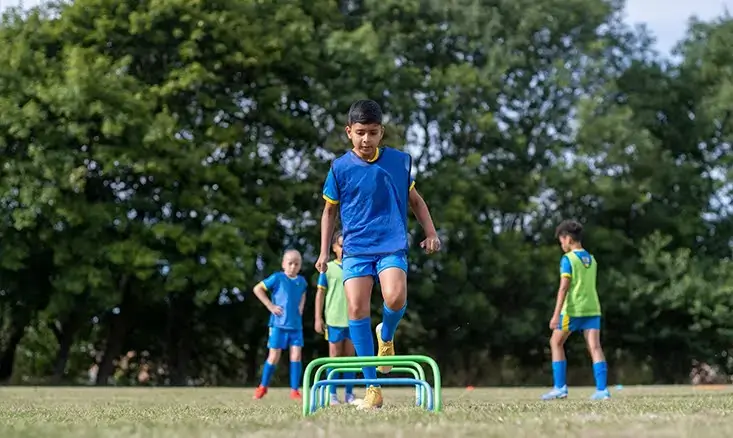
Age-Specific Attacking Drills
Age-specific attacking drills are designed to meet the developmental needs of different age groups in youth soccer. These drills focus on building foundational skills for younger players, while introducing more advanced techniques and tactical awareness as players grow older. By customizing drills for each age group, coaches can ensure that players progress effectively and enjoyably in their attacking abilities.
Engaging Drills for Younger Soccer Players
Engaging drills for younger soccer players are designed to make learning fun while developing essential skills. These drills incorporate games and activities that keep young players motivated and excited about practice. By focusing on enjoyment and skill-building, these drills help foster a love for soccer while improving dribbling, passing, and teamwork in an enjoyable and interactive environment.
Hot Box Drill
A small-sided game with goals in a confined area.
Objectives
Encourage quick thinking and fast play.
Key Coaching Points
Emphasize maintaining possession, quick passing, and creating space.
Flying Numbers Drill
Players attack in waves, simulating counter-attacks.
Objectives
Enhance speed and decision-making in transition.
Key Coaching Points
Focus on quick transitions, accurate passing, and getting numerical advantages.
Half and Half Drill
Half the field is used for attacking play, emphasizing quick transitions.
Objectives
Improve awareness and attacking coordination.
Key Coaching Points
Encourage players to switch play quickly, maintain possession, and create scoring opportunities.
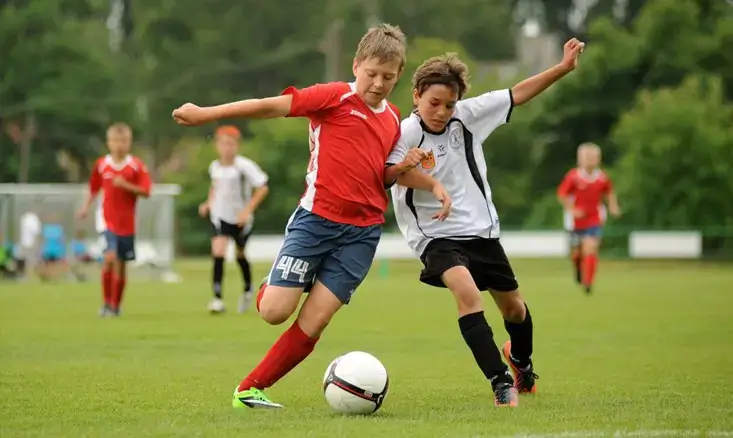
Soccer Attacking Drills for U12
For U12 players, focus on developing basic skills and understanding of attacking play. Drills like 3v3 games and dribbling through cones are ideal for this age group. These drills emphasize fundamental skills such as dribbling, passing, and shooting, while also introducing young players to the basic principles of attacking play. The goal is to build a strong foundation that players can build on as they progress.
Soccer Attacking Drills for U14
At this level, emphasize advanced skills and tactical awareness. Drills that involve more complex passing patterns and positional play help U14 players improve. For example, exercises that focus on creating and using space, such as overlapping runs and combination play, are essential. These drills help players develop a deeper understanding of the game and improve their ability to read and react to different situations.
Soccer Attacking Drills for U16
For U16 players, integrate complex tactics and team play. Full-sided games and scenario-based drills that mimic real match situations are highly beneficial. These drills should focus on developing advanced technical skills, tactical understanding, and strategic thinking. By simulating game-like scenarios, players can practice executing complex attacking strategies and improve their ability to make quick, informed decisions under pressure.
Advanced Attacking Drills for Youth Soccer Players
Advanced attacking drills for youth soccer players are designed to refine their offensive skills and tactical understanding. These drills focus on complex techniques such as combination play, quick transitions, and decision-making under pressure. By practicing advanced drills, players can enhance their ability to execute strategic plays, improve their coordination with teammates, and become more effective in challenging game situations.
Drills to Improve Decision-Making in Attack
Scenario-based drills that force players to make quick decisions.
Objectives
Develop tactical awareness and quick thinking.
Key Coaching Points
Emphasize reading the game, making the right decisions, and executing them under pressure.
Attacking through the Middle Drill
Focus on creating and using space in the central areas.
Objectives
Improve passing accuracy and movement off the ball.
Key Coaching Points
Encourage players to find and use gaps, make incisive passes, and move intelligently off the ball.
Building Attacks from the Back
Players practice starting attacks from the defensive third.
Objectives
Enhance composure and build up play.
Key Coaching Points
Emphasize playing out from the back, maintaining possession, and building attacks patiently.
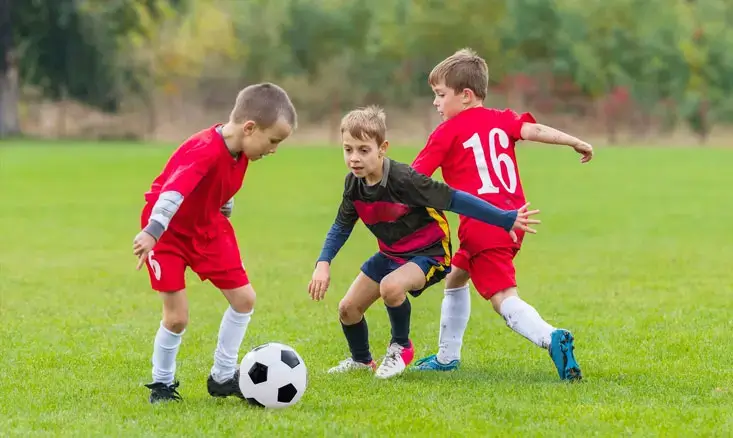
Formation-Specific Attacking Drills
Formation-specific attacking drills are designed to optimize offensive strategies within different soccer formations. These drills help players understand their roles and responsibilities in formations like 3-5-2 or 4-3-3, enhancing teamwork and positioning. By practicing these drills, players can learn how to use the strengths of their formation, create scoring opportunities, and adapt to various game situations effectively.
Attacking Drills for 3-5-2 Formation
In a 3-5-2 formation, using wing play and midfield dominance is key. Drills should focus on overlapping runs and quick transitions from defense to attack. For example, wing-back drills that emphasize crossing and finishing can help players understand their roles in creating scoring opportunities from wide positions. Midfielders should practice supporting the attack by making late runs into the box and providing options for the wing-backs.
Attacking Drills for 4-3-3 Formation
This formation utilizes width and the forward three. Drills that encourage wide players to deliver crosses and forwards to make dynamic runs into the box are essential. For example, exercises that focus on quick ball movement and creating overloads on the wings can help players use the spaces left by the opposition. Forwards should practice making diagonal runs and timing their movements to receive crosses from the wide players.
Importance of Attacking from Wide Positions
Creating space and stretching defenses is crucial in youth soccer. Using the full width of the pitch allows teams to break down compact defenses and create scoring opportunities. Wide play forces the opposition to spread out, creating gaps that attackers can use. Effective use of width also provides more crossing opportunities, increasing the chances of scoring from wide positions.
Drills to Enhance Wide Attacks
Drills to enhance wide attacks focus on improving players’ ability to use the full width of the field to create scoring opportunities. These drills emphasize crossing, dribbling along the sidelines, and making effective runs into wide areas. By practicing these techniques, players can learn to stretch the defense, deliver accurate crosses, and finish from wide positions, making their team more versatile and dangerous in attack.
Cash in on Overloads
Players practice using numerical advantages on the flanks.
Objectives
Improve decision-making and crossing accuracy.
Key Coaching Points
Emphasize quick passing, movement off the ball, and accurate crossing.
The Flanks Drill
Focus on delivering crosses from wide positions.
Objectives
Enhance crossing and finishing skills.
Key Coaching Points
Encourage players to take on defenders, deliver accurate crosses, and make timely runs into the box.
Cross and Finish Drill
Wingers deliver crosses while attackers time their runs to finish.
Objectives
Improve coordination and timing between wingers and strikers.
Key Coaching Points
Focus on the quality of crosses, the timing of runs, and finishing techniques.
Incorporating Drills into Training Sessions
Incorporating drills into training sessions ensures a well-rounded development of players’ skills. By structuring training sessions with a mix of warm-up activities, focused drill segments, and cool-down exercises, coaches can maximize the effectiveness of practice. Balancing skill development with fun, engaging drills keeps players motivated and enhances their learning, leading to continuous improvement and a deeper understanding of the game.
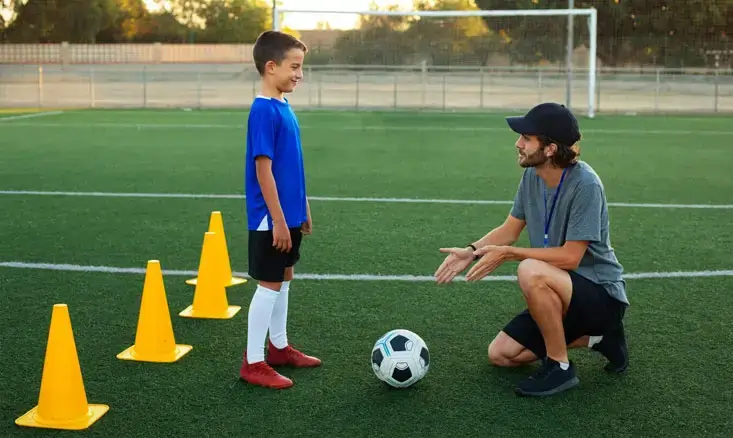
Structuring a Training Session
Warm-up Activities
Light exercises to prepare muscles. For example, dynamic stretches and light jogging to get players ready.
Main Drill Segments
Focused practice on specific skills. Include a variety of drills to cover different aspects of attacking play.
Cool-down and Review
Gentle exercises and discussion of the session. Stretching and light activities to help players recover, followed by a review of what was learned.
Balancing Skill Development and Fun
Keeping Players Engaged
Mix drills with fun games. Ensure that training sessions are enjoyable to keep players motivated.
Ensuring Comprehensive Skill Coverage
Rotate drills to cover all aspects of attacking play. Make sure that sessions address different skills and tactical concepts.
Adapting Drills for Different Skill Levels
Modifying Complexity
Adjust drill difficulty based on player ability. Make drills more challenging for advanced players and simpler for beginners.
Ensuring Inclusivity and Progression
Design drills to include all players and track their progress. Provide opportunities for every player to develop and improve.
Conclusion
Developing effective attacking skills in youth soccer requires a mix of individual skill development, teamwork, and tactical awareness. By incorporating a variety of drills into regular training sessions, coaches can ensure their players are well-equipped to excel on the field. Keep the training sessions engaging and challenging for continuous improvement and a love for the game.
FAQs
How can young soccer players practice attacking skills effectively?
Young soccer players can practice attacking skills by engaging in various drills that focus on dribbling, shooting, passing, and quick decision-making. Drills like 2v2 with target players, 1v1 battles, and 4v4 passing games are particularly effective as they simulate game-like scenarios and encourage active participation.
What are the core principles of attacking in soccer drills?
The core principles of attacking in soccer drills include maintaining possession, creating scoring opportunities through strategic passing and movement, and developing quick decision-making skills. Drills are designed to enhance teamwork, communication, and understanding of different formations that influence attacking strategies.
How can players improve their attacking effectiveness in soccer?
Players can improve their attacking effectiveness by participating in drills that sharpen their dribbling, passing, and shooting skills under pressure. Emphasizing quick transitions, using space wisely, and practicing scenario-based drills help players make better decisions and become more formidable attackers.
What techniques are used to practice advanced soccer play?
To practice advanced soccer play, coaches can implement drills that involve high-intensity, competitive scenarios like small-sided games or drills that require quick transitions and assertive actions, such as the “Flying Numbers Drill” where players attack in waves, simulating counter-attacks.
What strategies are essential for successful soccer attacks?
Successful soccer attacks rely on the effective use of formations, understanding roles within these formations, and executing well-coordinated movements. Drills that focus on attacking through wide positions or building attacks from the back are crucial for teaching players how to exploit space and create scoring opportunities strategically.

Did you find this useful?

LATEST BLOGS
GET IN TOUCH WITH US

